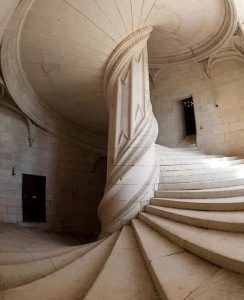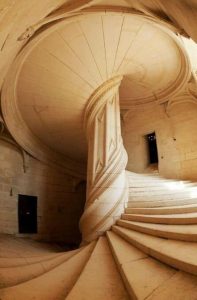Staircase designed by Leonardo da Vinci, 1516.
The staircase designed by Leonardo da Vinci in 1516 is an intriguing example of his innovative thinking and mastery of engineering principles. It was designed as a double helix staircase for the Château de Chambord in France, where Leonardo was working for King Francis I.
What makes this design particularly remarkable is its structure: the staircase consists of two spiraling, intertwined staircases that run parallel to each other but do not intersect. This allows people to ascend and descend simultaneously without ever crossing paths. The design of the staircase is an early expression of Da Vinci’s fascination with both aesthetics and function.
While the staircase is often attributed to Leonardo da Vinci, there is some debate about whether he personally designed it or if his ideas were implemented by other architects. Nevertheless, it reflects his genius in combining artistic beauty with advanced engineering concepts, long before the principles became common in architectural design.

The Double Helix Design
The most striking feature of the staircase is its double helix structure, which consists of two intertwined spirals. One spiral is used for ascending and the other for descending, allowing people to pass each other without ever coming into direct contact or crossing paths. This was a remarkable innovation for its time, as it created a smooth and efficient flow of movement between levels.
Key aspects of the double helix design:
Duality of function: The two staircases are connected at different levels, allowing for simultaneous use without any interference. This idea of separating traffic flows is not something commonly seen in architecture today, and it shows Da Vinci’s ability to think about spatial dynamics and user experience.
Visual impact: The design also has an aesthetic dimension. From a visual perspective, the intertwined spiral staircases are elegant and give a sense of fluidity and movement, almost as if the staircase itself is a living form.
Engineering genius: While it may look effortless, designing a staircase with two helixes that function independently requires precise calculations of load distribution, structural integrity, and balance. Da Vinci, with his extensive knowledge of physics and anatomy, could have anticipated these challenges.
The Château de Chambord and Its Context
The Château de Chambord is a Renaissance-era French castle located in the Loire Valley, and it is one of the most famous and iconic castles in France. King Francis I commissioned the construction of Chambord in 1519, with the intention of creating a royal hunting lodge.
In 1516, Leonardo da Vinci moved to France at the invitation of Francis I, bringing with him his talents in art, engineering, and architecture. While he was not the chief architect of Chambord, he is often credited with contributing to the overall design of the château, including the staircase. It is believed that his ideas influenced the final architectural plan.
Da Vinci’s involvement in the project is emblematic of the close relationship between Italy and France during the Renaissance. Francis I was an avid admirer of Leonardo and his work, and he gave him the title of Premier Painter and Engineer and Architect to the King.
The Structure of the Staircase
Leonardo’s design for the Chambord staircase was based on principles of symmetry and mathematical precision. Some elements of his design were inspired by his studies of human anatomy, particularly the mechanics of the human body in motion, which he sketched in detail in his famous Vitruvian Man.
The staircase itself consists of a central support column surrounded by the two spirals. The ingenious part is how the two staircases are separated by a central void, but the walls are designed in such a way that they do not impede the flow of movement. The stairs spiral in a way that allows people to rise or descend at the same time but on separate, winding paths. This clever separation reduces congestion and improves the efficiency of movement.
Though the staircase is relatively simple in its overall form, it incorporates Da Vinci’s principles of perfect proportion, balance, and elegance. It reflects a perfect harmony of beauty and practicality that is characteristic of Renaissance architecture.

The Influence of Da Vinci’s Work
Leonardo’s ideas, including his architectural concepts, were highly influential in Renaissance Europe. Though he is often better known for his paintings, his engineering and architectural works demonstrate an extraordinary foresight. His study of the mechanics of the human body, optics, and geometry were all reflected in his approach to design.
While the staircase at Chambord is the most famous example of Leonardo’s architectural designs, it is just one of many in which his work blended art and science. Da Vinci was fascinated with the mechanics of structures and the movement of people, often exploring ways to optimize both beauty and function. His writings and sketches on architecture, which include designs for bridges, machines, and fortifications, are a testament to his forward-thinking.
Why the Design is Still Relevant
The Chambord staircase is still an architectural marvel that captures the essence of Renaissance thinking. Da Vinci’s vision of space, geometry, and functionality has influenced modern architectural design. Even today, the idea of creating circulation systems in buildings that separate or direct movement without conflict is a common principle in contemporary architecture.
The staircase also embodies principles of efficiency that are still studied by engineers and designers. The use of two helix-like spirals is often studied in design schools today for its unique approach to maximizing spatial utility.
The Cultural and Artistic Legacy
Aside from its architectural significance, the staircase is a symbol of the Renaissance era itself, a period when art, science, and engineering came together in remarkable ways. Da Vinci’s contributions during this period were not limited to painting and sculpture but extended to innovations in technology, anatomy, and architecture.
The staircase at Chambord has also become a cultural icon, representing the seamless union of art and science that Da Vinci embodied. Today, visitors to the Château de Chambord are drawn to the elegant, almost mysterious design of the staircase, which continues to captivate and inspire awe more than 500 years after it was conceived.
Conclusion
Leonardo da Vinci’s staircase at Château de Chambord is a remarkable architectural achievement that blends aesthetic beauty with functional design. Its double helix structure is a testament to Da Vinci’s understanding of both physics and human movement, as well as his ability to envision solutions to complex spatial problems. Even though some of the finer details of his role in the design remain uncertain, the staircase remains a lasting legacy of his genius and a symbol of the Renaissance ideal that art and science can, and should, work together in harmony.

